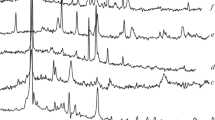Summary
-
1.
A study has been made of the effect of compression at 20,000 aim on the properties of zinc oxide, titanium dioxide, thorium dioxide, and normal calcium phosphate in dehydrogenation and dehydration reactions characteristic for these catalysts.
-
2.
It has beer, shown that as a result of compression the apparent specific volume of these catalysts is reduced by the factors indicated:
-
Zinc oxide3.3
-
Titanium dioxide2.0
-
Thorium dioxide1.5
-
Calcium phosphate2.2
-
3.
The selectivities in the action of zinc oxide in the dehydrogenation of isobutyl alcohol and in the action of calcium phosphate in the dehydration of formic acid were fully retained after compression. In the case of thorium dioxide also, compression had no effect on the relative rates of the two courses of the decomposition of ethyl alcohol. On the other hand. in presence of compressed titanium dioxide the ratio of the degree of dehydrogenation of alcohol to its degree of dehydration is lower than in presence of the noncompressed sample. It is probable that the change in the specificity of titanium dioxide due to compression is associated with change in its porosity characteristics and with the difficulty with which the dehydrogenation product (acetaldehyde) is desorbed from the catalyst.
-
4.
In all cases the activation energy of the reaction is the same, whether the catalyst is compressed or not.
-
5.
The activities of the investigated catalysts were altered in various ways by compression. The activity per unit weight was reduced for all catalysts apart from thorium dioxide, but the activity per unit volume rose for all catalysts except calcium phosphate, the activity of which was halved.
-
6.
None of the investigated catalysts underwent any change in crystal structure when compressed.
I am grateful to A. M. Rubinshtein for the X-ray analysis of the catalysts.
Similar content being viewed by others
Literature cited
V. A. Plotnikov, K. N. Ivanov, and D. A. Pospekhov, J. Appl. Chem., 8, No. 2, 125 (1931); Huttig, Kos:elitz. Z. Electrochem., 39. 362 (1932); B. Kemper. Catalytic Decomposition Reactions, Washington, 1938; P. Ivannikov. J. Gen. Chem., 9, 176 (1939); N. P. Kurin and F. D. Perminov, Bull. Tomsk Polytech. last., 64, 121 (1948).
L. F. Vereshchagin. L. Kh. Freidlin, A. M. Rubinshtein, and I. U. Numanov, Bull. Acad. Sci. USSR, Div. Chem. Sci., No. 6, 809(1951).
L. Kh. Freidlin. L. F. Vereshchagin, 1. E. Neimark, I. U. Numanov, and R. Yu. Sheinfain, Bull, Acad. Sci. USSR, Div. Chem. Sci., No. 5, 945(1953).
H. Adkins, W. A. Lazier, J. Am. Chem. Soc., 48, 1671 (1926).
A, E. Agronomov, Bull. Moscow State Univ., No. 2, 109 (1951).
P. I. Kutseva, Thesis, Moscow, Inst. Phys. Chem.Acad. Scl. USSR, 1952.
A. M. Rubinshtein and S. G. Kulikov. Bull. Acad. Sci. USSR, Div. Chem. Sci., 84 (1950).
A. A. Tolstopyatova, Bull. Moscow State Univ., No. 3, 49 (1951).
L. Kh. Freidlin and A. M. Levit, Bull. Acad. Sci, USSR. Div. Chem. Sci., No. 5, 625 (1951).
Author information
Authors and Affiliations
Rights and permissions
About this article
Cite this article
Vereshchagin, L.F., Freidlin, L.K., Numanov, I.U. et al. Effect of compression on the properties of dehydrogenation and dehydration catalysts. Russ Chem Bull 3, 127–132 (1954). https://doi.org/10.1007/BF01195434
Received:
Issue Date:
DOI: https://doi.org/10.1007/BF01195434




